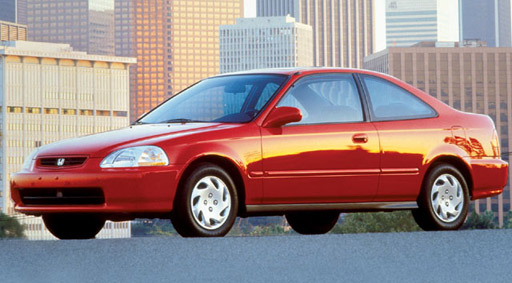 Multi-site research, including the reputable German company ADAC, and user reviews indicate, that this Honda model is characterized by high-quality workmanship, relatively low failure rate and high operational reliability. It is available as three- and a five-door kombilimousine, four-door limousine and station wagon known as Aerodeck. The three-door and four-door versions produced in Japan differ, m.in. the shape of the headlamps, type of air flow and fan control switches as well as upholstery materials.
Multi-site research, including the reputable German company ADAC, and user reviews indicate, that this Honda model is characterized by high-quality workmanship, relatively low failure rate and high operational reliability. It is available as three- and a five-door kombilimousine, four-door limousine and station wagon known as Aerodeck. The three-door and four-door versions produced in Japan differ, m.in. the shape of the headlamps, type of air flow and fan control switches as well as upholstery materials.
Honda's advantage, known for years, is the family of high-speed engines with various capacities and high power, ensuring very good dynamic properties. The car can be powered by engines with a capacity of 1,4-1,8 dm3 of capacity 66-124 kW. Among them there are also units equipped with the VTEC valve timing change mechanism, which adds dynamics to engines, significantly increasing the car's performance.
The sixteen-valve Honda power unit, equipped with one overhead camshaft, has a capacity 1396 cm3 and has a power comparable to engines of other brands, np. Ecotec Opla. Works at compression ratio 9,2 and although the manufacturer recommends gasoline with an octane rating 95, this taking into account the different quality of fuels available in different parts of the country, can be said, that the engine behaves much better on high-octane gasoline 98.
The Honda power unit shows its dynamics in the ranges 2200-3000 i 4000-5000 obr./min, but then, what to hide, you can hear a characteristic "purr" inside the car with an efficient exhaust system. In my opinion, it is too noisy when traveling with four people on board. Mechanically, the engine is flawless. During almost three years of operation, it ran without faults 70 thousand. kilometers, consuming depending on the ambient temperature and load 7,2+10 dm3 of gasoline per 100 kilometers, which is slightly more than the market competitors. If we are going with the air conditioning system on (continuous cooling of the air blown into the cabin) with the speed limit on the motorway, we observe it, like the needle of the fuel gauge moves quickly down and we quickly give up this substitute of luxury.
The car's suspension is a different structure than that used by the competition, it is springy and has some sporty features.
It is hard to find here wishbones made of pressed steel. Very solid forgings were used, durable and mechanically resistant. Properly selected elements, supported by tilt stabilizers, they make, that the car moves straight ahead and takes corners easily. These features are definitely a strong asset of the Civic.
Compared to the car of the previous generation imported directly from Japan, the described model was not assembled so thoroughly. From the beginning of use, while driving, there were knocks in the rear of the body. In the service, the door fitted exactly, the fastening of the shelves has been checked, the backrests of the rear seats and the seat belts. After many tries, ended with a ride in the trunk, finally the culprit was identified, which turned out to be a defective shock absorber lifting the rear door. After replacing this item, the knocks stopped. From the beginning of operation, the fuel gauge was inaccurate, showing a minimum, when there was approx 12 liters of fuel. Gearbox in gear ratios 1-5 works very well, but requires careful and accurate reverse gear engagement, otherwise, repeat this step. But as the service technicians said, this is the "beauty" of this box model. In a model with air conditioning in the conditions of Polish harsh winter, heating the interior of the vehicle could be more efficient.
The placement of an additional brake light at the lower edge of the rear window also seems controversial, where it reduces visibility and prevents the application of a rational horizontal rest position of the rear window wiper, not vertically. Completely Japanese is the switch that controls the front and rear wipers. You have to train, to choose the desired function correctly.
Honda Civic with engine 1.4 requires technical inspections connected with the replacement of engine oil and central heating filter 10 thousand. kilometers. It needs to be highlighted that, that other elements wearing out during operation are characterized by high durability. In the car, which has traveled over 70 thousand. kilometers, no mechanical parts were replaced. The factory set of brake pads did not wear out until after the mileage 40 thousand. km, and the brake discs were replaced after 71 thousand. km.
In this brand, only original spare parts guarantee long service life. This is true for the different parts, from wiper blades, and the brake pads. Such parts are not cheap, however, they guarantee user satisfaction. Performing reviews of every 10 thousand. km deviates from the frequency achieved by other brands and raises costs, however, the maintenance of the website, more frequent than that of competitors so far, pays off in failure-free operation.
-
Recent Posts
Categories
Tags
- security
- Bora
- Camry
- Carina
- Escort
- rims
- Fiat
- Fiesta
- Ford
- armchair
- car seats
- Galloper
- brake
- Hyundai
- Ibiza
- magnetyzer
- Maverick
- Mazda
- body
- Nissan
- Octavia
- heating
- fuel
- seatbelts
- Peugeot
- hub
- joints
- Point
- Rover
- Saab
- Samurai
- lockers
- Seat
- Sierra
- engine
- Skoda
- lubrication
- Subaru
- Suzuki
- Toyota
- tuning
- Volkswagen
- Volvo
- buy
- bearing
-
Popular articles
Translation
Bookmarks





